Veteran
A veteran (from Latin vetus, meaning "old") is a person who has had long service or experience in a particular occupation or field.[1] A military veteran is a person who has served and is no longer serving in a military.[2] Military veterans that have served directly in combat in a war are further defined as war veterans (although not all military conflicts, or areas in which armed combat took place, are necessarily referred to as wars).
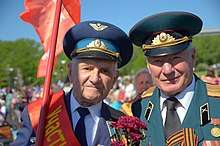
Public attitude towards veterans
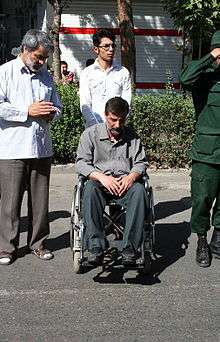

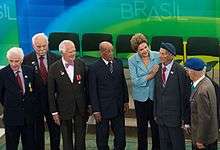
Military veterans often receive special treatment in their respective countries due to the sacrifices they made during wars. Different countries handle this differently: some openly support veterans through government programs, while others ignore them. Veterans are also subject to illnesses directly related to their military service such as posttraumatic stress disorder (PTSD). War veterans are generally treated with great respect and honour for their contribution to the world and country by their own nationals. Conversely there are often negative feelings towards the veterans of foreign nations held long after the war is over; for example towards the German Nazi soldiers, yet they are no less veterans of war than those of the winning side. There are exceptions. Veterans of unpopular or lost conflicts may be discriminated against. Veterans of short or small conflicts are often forgotten when the country fought bigger conflicts. In some countries with strong anti-military traditions (e.g., Germany after 1945), veterans are neither honoured in any special way by the general public, nor have their dedicated Veterans Day, although events are sometimes orchestrated by minority groups.
Many countries have longstanding traditions, ceremonies, and holidays to honour their veterans. In the UK, "Remembrance Day" is held on November the 11th and is focused mostly on the veterans who died in service to the monarch and country. A red or white poppy is worn on the lapel (for remembrance or for peace, respectively) in the weeks up to the date, and wreaths and flowers laid at memorials to the dead.
In Russia, a tradition was established after World War II where newly married couples would on their wedding day visit a military cemetery. In France, for instance, those wounded in war are given the first claim on any seat on public transit. Most countries have a holiday such as Veterans Day to honour their veterans, along with the war dead.
In Zimbabwe, the term veteran is used for political purpose and may not actually refer to someone that participated in a war, but rather to someone who feels entitled to some benefit because of association with a cause for which there had been an actual war.[3]
Veterans' experiences around the world
Britain
Ex-service is British terminology for veterans, which refers to those who have served in the British Empire or Commonwealth Armed Forces. [4][5][6]
Britain, with its historic distrust of standing armies, did little for its veterans before the 19th century. It did set up two small hospitals for them in the 1680s. In London and other cities the streets teemed with disabled or disfigured veterans begging for alms.[7]
The First World War focused national attention on veterans, especially those who had been partly or wholly disabled.[8] The King's National Roll Scheme (KNRS) was an employment program for disabled veterans of the First World War. Kowalsky says it was practical, innovative, and ahead of its time and was the most important piece of legislation enacted for disabled veterans in interwar Britain. In addition to direct aid, it stimulated a national discussion regarding the need for employment programs for disabled veterans and the responsibility of the state, setting up a future demand for more benefits.[9]
In the 21st century, Britain has one of the highest densities of veterans in a major country, with 13 million in 2000, or 219 per 1,000 population.[10]
The Congo
Some veterans from the Belgian commitment of the Congolese to WWII live in communities throughout the Congo.[11] Though they received compensation from the government during the rule of the dictator Mobutu Sese Seko, after his overthrow they no longer receive pensions.[11]
United States
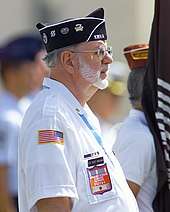
In the United States, a veteran is a person who has served in the armed forces (the United States National Guard and Reserve included) and were discharged under conditions other than dishonorable.[12] A common misconception is that only those who have served in combat or those who have retired from active duty can be called military veterans.
In 1990, 40% of young Americans had a veteran for a parent; this decreased to 16% in 2014.[13] In 2016, of the veterans who were born outside of the United States, Mexican and Filipino Americans made up the two largest populations, with 3% of all veterans having been born outside of the United States.[14] As of 2017 there are some 21 million American veterans.[15]
According to the Pew Research Center, "Among men, only 4% of millennials [born 1981-96] are veterans, compared with 47%" of men in their 70s and 80s, "many of whom came of age during the Korean War and its aftermath."[16]
Veterans' benefits in the United States
President Abraham Lincoln, in his second inaugural address in 1865 towards the end of the American Civil War, famously called for good treatment of veterans: "[T]o care for him who shall have borne the battle, and for his widow, and his orphan". The American Civil War produced veterans' organizations, such as the Grand Army of the Republic and United Confederate Veterans. The treatment of veterans changed after the First World War. In the years following, discontented veterans became a source of instability. They could quickly organize, had links to the army and often had arms themselves. The Bonus Army of unemployed veterans was one of the most important protest movements of the Great Depression, marching on Washington, D.C. to get a claimed bonus now that Congress had promised them decades in the future.
Each state of the United States sets specific criteria for state-specific veterans' benefits. For federal medical benefits from the Department of Veterans Affairs (VA) hospitals, prior to 7 September 1980 the veteran must have served at least 180 days of active duty, after the above-mentioned date the veteran must have served at least 24 months. However, if the veteran was medically discharged and receives a VA service-connected disability stipend, the time limits are not applicable.
American veteran experience after World War II
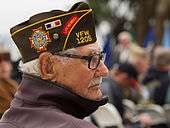
After the Second World War, in part due to the experience of the First World War, most of the participating states set up elaborate veterans' administrations. Within the United States, it was veterans groups, like the American Legion and Veterans of Foreign Wars organization, that pushed for and got the G.I. Bill enacted. These gave veterans access to free or subsidized education and health care. The newly educated GIs created a significant economic impact, and with the aid of VA loans were able to buy housing and establish themselves as part of a growing American middle class. The explosion of the suburbs created sufficient housing for veterans and their families.
American veteran experience after OEF and OIF
Many veterans of Operation Enduring Freedom and Operation Iraqi Freedom have had to face challenges unique to warfare in the 21st century. One significant difference between OEF and OIF and previous wars is a greater dependence on reservists and repeat deployments. Up to 80% of troops deployed at the beginning of OEF were part of the National Guard and Reserve[17] and about 40% of currently serving military members have been deployed more than once.[18] This has meant that many deployed troops, not being as “ steeped in military culture ”[19] have had more difficult transitions into military life, and for many the increased redeployment rate has meant more transitions, more uncertainty, longer terms, and shorter dwell times, all of which contribute to greater stress.
Due to medical advances, warfare in the 21st century tends to yield more survivors with severe injuries which soldiers in previous wars would have died from.[18] This means that, though fewer service members die, more return from war with injuries more serious, and in turn more emotionally devastating, than ever before. Among these injuries is the increasingly common traumatic brain injury, or TBI, the effects of which can range from a mild concussion to amnesia and serious neurological damage.[20]
Female veterans in the U.S.
Women have served in the United States military for over two hundred years. Some female veterans perceive themselves as discriminated against by their male counterparts and, as such, women who have served in the armed forces have sometimes been known as "the invisible veterans".[21] Women were not fully recognized as veterans until after WWII, and prior to this they were not eligible for VA benefits. The current percentage of U.S. Veterans who are women is more than 8 percent. Women make up nearly 11.6 percent of OEF/OIF/OND Veterans.[22] A tri-state (Washington, Idaho, Oregon) women veterans conference in Pendleton, Oregon, in April 2008, attracted 362 women veterans, according to the East Oregonian newspaper. A growing number of states are recognizing June 12th as Women Veterans Day, either through proclamation or legislative action.
On August 5, 2011, Erica Borggren was appointed Director of the Illinois Department of Veterans Affairs and has been "creating a new Women Veterans Program to help address the issue that women veterans often do not self-identify as veterans and do not take advantage of veterans’ benefits to the same extent as their male peers."[23] She gathered in a webcast panel moderated by Stacey Baca with Dr. Rebecca J. Hannagan and Kimberly Mitchell at the Pritzker Military Library on January 24, 2013, to discuss important issues facing female veterans in today's military.[23]
African American veterans in the U.S.
African Americans have participated in every war fought by or within the United States. Black veterans from World War I experienced racial persecution on returning to the U.S. from overseas, particularly in Southern cities.[24] Black veterans from World War II continued to be denied equality at home despite President Harry S. Truman's desegregation of the military after World War II. Black veterans went on to play a central role in the civil rights movement of the 1950s and 1960s. The National Association for Black Veterans is an organization that provides advocacy and support for African American and other minority veterans.
Health effects of military service and treatment for veterans
The effect of active military service can be profound and lasting, and some veterans have found it difficult to adjust to normal life again. Figures from 2009 showed that twice as many veterans were in prison than there were British troops currently in Afghanistan. Homelessness, street-sleeping and relationship breakdown are also commonly reported.[25][26] Research done by the UK homelessness charity CRISIS (1994) and the Ex-Services Action Group (1997) both found that a quarter of homeless people had previously served in the armed forces.[27] The Times newspaper reported on 25 September 2009 that in England and Wales the number of "military veterans in jail has more than doubled in six years".[28] Another Times article of the same date quoted the veterans mental health charity Combat Stress[29] as reporting a 53% increase in referrals from doctors.
Suicide
An article in the London Metro on 28 January 2010 was titled "Veterans prone to suicide" and cited a report by the Mental Health Foundation[30] which said that not enough was being done to care for the Afghanistan war veterans, and many "plunged into alcohol problems, crime and suicide" upon their return. Indeed, in the U.S., the suicide rate among veterans is 300% the national average.[31] They account for 30% of the suicides in the US annually.[32] Support services were found to be patchy from area to area.
Posttraumatic Stress Disorder
Posttraumatic Stress Disorder (PTSD) is a condition that affects a significant number of veterans. Studies involving veterans with combat-related PTSD indicate that between 4-17% of United States veterans have been diagnosed with PTSD. Their United Kingdom counterparts, however, have significantly lower numbers of just 3-6%.[33]
New treatment programs are emerging to assist veterans suffering from post-combat mental health problems such as depression and PTSD. Cognitive Behavioral Therapy (CBT), is becoming an important method for the treatment of mental health issues among veterans, and is currently considered the standard of care for depression and PTSD by the United States Department of Defense. CBT is a psychotherapeutic approach that aims to change the patterns of thinking or behavior that responsible for patient's negative emotions and in doing so change the way they feel. It has been proven to be an effective treatment for PTSD among war veterans. Recently, online programs that pair CBT with therapist interaction have also proven effective in treating mental health problems among veterans. Eye Movement Desensitization and Reprocessing (EMDR) is also an effective and noninvasive, drug-free treatment for PTSD, although it has not been tested against specific military traumatic exposure for efficacy.
Veterans under the age of 25 are at higher risk for PTSD than veterans older than 25. Younger veterans with severe PTSD are at higher risk for metabolic syndrome and suicide.[32]
Music therapy provides veterans with a way to express themselves, escape from anxiety, and helps them cope with their PTSD. In Marty Steiner's “Music and Science Meet…Music Therapy”, Steiner explains “Modern music therapy became a norm in the Veteran's Administration hospitals during and after both World Wars. In its most basic form the playing of recordings on the Victrola in WW I, hospitals had measurable positive effects on the wounded and shell-shocked patients. This began the use of a somewhat primitive music therapy in all American military hospitals.”[34]
Other disorders
Veterans are at higher risk than the general population for several disorders, especially younger veterans (those younger than 25). Younger veterans are at increased risk for drug use disorders, alcohol abuse disorders, and mental illnesses in general.[32]
Help for veterans
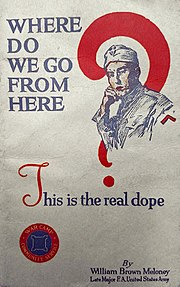
Necessity has resulted in a number of sources of help being made available for veterans. Many of these are independent, charitable organisations, and in some countries the aftercare and rehabilitation services provided by Governments have been inadequate.[35] This may be because they do not wish to give attention to the negative effects of military service and the difficulties of readjustment to civilian life for it may have an adverse impact upon recruitment for their armed forces. Nevertheless, help is available and veterans should feel able to make contact and ask for assistance or advice to the broad network of organizations, and to appropriate legislators, without feeling that this is a weakness. Military service can be a profoundly unnatural experience and it is likely that some help may be needed in debriefing and rehabilitation into the community, whether it be medical, psychological, practical or financial. There were an estimated 57,849 homeless veterans in the United States during January 2013, accounting for 12 percent of all homeless adults. Just under 8 percent of homeless U.S. veterans are female.[36]
References
- "Veteran - Define Veteran at Dictionary.com". Dictionary.com. Retrieved 20 May 2016.
- "Veteran". Merriam-Webster Dictionary. Merriam-Webster, Inc. Retrieved 19 July 2019.
- "The Politics of Disruption: War Veterans and the Local State In Zimbabwe". Retrieved 20 May 2016.
- "Ex-service definition and meaning | Collins English Dictionary". www.collinsdictionary.com. Collins Dictionary. Retrieved 17 February 2020.
- "Veterans guaranteed job interviews". BBC News. 6 February 2020. Retrieved 17 February 2020.
- Iversen, Amy; Dyson, Claire; Smith, Naomi; Greenberg, Neil; Walwyn, Rebecca; Unwin, Catherine; Hull, Lisa; Hotopf, Matthew; Dandeker, Christopher; Ross, John; Wessely, Simon (June 2005). "'Goodbye and good luck': The mental health needs and treatment experiences of British ex-service personnel". British Journal of Psychiatry. Cambridge University Press. 186 (6): 480–486. doi:10.1192/bjp.186.6.480. PMID 15928358. Retrieved 17 February 2020.
A cross-sectional telephone survey of 496 ‘vulnerable’ ex-service personnel selected from an existing epidemiological military cohort.
- Brumwell, Stephen (2002). "Home from the Wars". History Today. 52 (3): 41–46.
- Deborah Cohen, War Come Home: Disabled Veterans in Britain & Germany, 1919-1939 (2001)
- Kowalsky, Meaghan (2007). "'This Honourable Obligation': The King's National Roll Scheme for Disabled Ex-Servicemen 1915-1944". European Review of History. 14 (4): 567–584. doi:10.1080/13507480701752201.
- Dandeker, Christopher; et al. (2006). "What's in a Name? Defining and Caring for 'Veterans,'". Armed Forces & Society. 32 (2): 161–177. doi:10.1177/0095327x05279177.
- McCrummen, Stephanie (4 August 2009). "Nearly Forgotten Forces of WWII". Washington Post. Washington Post Foreign Service.
- "U.S.C. Title 38 - VETERANS' BENEFITS". www.govinfo.gov. U.S. Government Publishing Office. Retrieved 11 January 2020.
- "America's love affair with uniformed men is problematic". The Economist. 28 October 2017.
- Zong, Jie; Batalova, Jeanne (13 October 2016). "Immigrant Veterans in the United States". Migration Information Source. Migration Policy Institute. Retrieved 9 April 2018.
- C.K. (4 October 2017). "The rhetorical power of "support our troops"". The Economist.
- "How Millennials today compare with their grandparents 50 years ago". Pew Research Center. March 16, 2018.
- Darwin, Jaine, Kenneth Reich. "Citizen Soldiers Changed Forever: The Impact of OEF/OIF on Reserve and National Guard Troops and their Families" SOFAR USA
- "Returning Home from Iraq and Afghanistan: Preliminary Assessment of Readjustment Needs of Veterans, Service Members, and Their Families" Washington, D.C: National Academies Press, 2010
- Friedman, MJ. "Veterans' Mental Health in the Wake of War." The New England Journal of Medicine, v352 n13 (2005): 1287-90
- Bass, Elizabeth, and Heidi Golding "The Veterans Health Administration's Treatment of PTSD and Traumatic Brain Injury Among Recent Combat Veterans" Washington, DC: Congress of the United States, Congressional Budget Office, 2012
- Willenz, June A. (1994): "Invisible Veterans" Educational Record, v75 n4 p40-46, American Council on Education
- http://www.womenshealth.va.gov/WOMENSHEALTH/facts.asp
- "Citizen Soldier: Change and Challenges--Women in Today's Military" Pritzker Military Library Webcast January 24, 2013 Chicago, IL
- Maxine D. Rogers, et al., Documented History of Rosewood, Florida in January 1923, op.cit., pp.4-6 Archived May 15, 2008, at the Wayback Machine, accessed March 28, 2008; Clarence Lusane (2003), Hitler's Black Victims, p. 89.
- Tsai, Jack; Rosenheck, Robert A. (2015-01-01). "Risk Factors for Homelessness Among US Veterans". Epidemiologic Reviews. 37 (1): 177–195. doi:10.1093/epirev/mxu004. ISSN 0193-936X. PMC 4521393. PMID 25595171.
- Tsai, Jack; Harpaz-Rotem, Ilan; Pietrzak, Robert H.; Southwick, Steven M. (2012-05-29). "The Role of Coping, Resilience, and Social Support in Mediating the Relation Between PTSD and Social Functioning in Veterans Returning from Iraq and Afghanistan". Psychiatry: Interpersonal and Biological Processes. 75 (2): 135–149. doi:10.1521/psyc.2012.75.2.135. ISSN 0033-2747. PMID 22642433.
- "Veterans-uk.info".
- "Login". Retrieved 20 May 2016.
- "The Veterans' mental health charity - Combat Stress - Combat Stress". Retrieved 20 May 2016.
- "Archived copy". Archived from the original on 2010-03-01. Retrieved 2010-02-02.CS1 maint: archived copy as title (link)
- Jaffe, Greg (February 1, 2013). "VA study finds more veterans committing suicide". Washington Post.
- Meade, Barbara J.; Glenn, Margaret K.; Wirth, Oliver (March 29, 2013). "Mission Critical: Getting Vets With PTSD Back to Work". NIOSH: Workplace Safety and Health. Medscape and NIOSH.
- Richardson, Lisa K.; Frueh, B. Christopher; Acierno, Ronald (January 2010). "Prevalence Estimates of Combat-Related PTSD: A Critical Review". Australian & New Zealand Journal of Psychiatry. 44 (1): 4–19. doi:10.3109/00048670903393597. PMC 2891773. PMID 20073563.
- Steiner, Marty (25 April 2018). "Music and Science Meet...Music Therapy" – via ProQuest. Cite journal requires
|journal=(help) - Durboraw, Al (2010). Combat veterans rights : to the Department of Veterans Affairs, benefits, medical services, compensation, appeals, etc. Pittsburgh, PA: Dorrance Publishing Co. ISBN 978-1-4349-0409-6.
- "The 2013 Annual Homeless Assessment report (AHAR) to Congress" (PDF). The U.S. Department of Housing and Urban Development. p. 42.
Further reading
- Durflinger, Serge Marc. Veterans with a Vision: Canada's War Blinded in Peace and War (2010)
- Edele, Mark. Soviet Veterans of World War II: A Popular Movement in an Authoritarian Society, 1941-1991 (2009) excerpt and text search
- Mann, Gregory. Native Sons: West African Veterans and France in the Twentieth Century (2006)
- Millington, Chris. From Victory to Vichy: Veterans in Interwar France (2012)
- Pencak, William, ed. Encyclopedia of the Veteran in America (2 vol 2009), with primary sources; excerpt and text search
- Pencak, William. For God & Country: The American Legion, 1919-1941 (1989)